Electric and electronic sound: the
tone generator as a musical instrument
Even long before the invention of the loudspeaker
and the amplifier, scientists discovered that is was possible to generate sounds
by pure electric means. These discoveries have inspired artists up to today,
as very regularly we see contraptions based on these discoveries in performances
and audio-art projects all over the world.
Likely the most important of such discoveries
were:
1.- electromagnetic generation of sound:
AC-current generators
2.- electrostatic generation of sound: the
singing arc
3.- optomechanical and optoelectric generation
of sound: August Lauste
Let's dig a little further into these technologies to see in
how far they are still relevant for music practice today.
1.- Electromagnetic sound generation
Whenever a magnetic field changes, these changes can be converted
to an alternating current by approaching the field with an inductor. This finding
is at the base of technological realisations ranging from the motor, the alternator,
the transformer, radio and TV broadcast and reception, radar technology... A
large series of musical instruments based on electromagnetism has seen the light
in the 20th century: the electric guitar, the clavinet, the Hohner Pianet, the
Fender-Rhodes piano, the neo-Bechstein, the Hawai-guitar, the Chapman stick...
One of the very first electric instruments -the telharmonium,
invented and build by Tadeusz Cahill, dates from even before the loudspeaker
was invented. At the base of this instrument was the observation that an alternator
(or dynamo) generates an alternating current whereby the frequency is a function
of the number of magnetic poles wound on the alternator and on the speed of
rotation of the rotor. By steering the speed of rotation it appeared possible
to generate tones tuned to precise frequencies. By loading the so generated
current with resistors, the amplitude could be controlled as well. As we all
know, any alternating current in as far as its frequency falls in the audio
range for human perception and its amplitude reaches out, can be considered
the equivalent of a musical tone. In order to turn such a current into a tone,
a device is needed to convert electric energy into vibration of air. Tadeusz
Cahill had the smart, but still quite bizare, idea to offer (and sell...) the
musical result of his telharmonium via the public telephone system! Listeners
had to call a number and could then listen to a musical piece, generated in
real time at the generator station. No matter how smart the idea, the company
for the exploitation of the Telharmonium went bankrupt. The instrument did not
survive in working condition.
2.- Another and completely different way for generating sound
via electricity was the singing arc. A periodic discharge of a tuned LC circuit
through an airgap between carbon electrodes caused a tone as a result of the
fast heating and cooling of air particles in the gap and the compression/decompression
as a result of this.
The ionic tweeter is another component in this category, using
ionic wind caused by a very sharp point loaded with a very high voltage. By
modulating the voltage, a sound wave can be generated.
High voltage sparks have been seen in quite a few audio art
installations: Takehisa Kosugi (+), Rolf Julius (+), Ron Kuivila... Technically
these installations often used the same technology that also underlies the electric
lighter or the piezo-electric ignitor on water boilers running on combustible
gas. The sound that accompanies the spark is a short and dry spike.
Our own 'Talking Flames' project can be considered to be the
first pure digital loudspeaker, the digital to analog conversion taking place
in the continuous spark between two slightly radio-active thorium-enriched tungsten
electrodes.
3.- Optical registration of sound vibrations is a technology
invented by August Lauste quite some time before the electromechanical recording-
and playback devices said to have been invented by Thomas Edison.
Only with the advent of the loudspeaker -an electromagnetic
device using a light paper cone to convert vibrations of an electromagnet into
vibrations of air - electric and electronic sound generation became practical.
The 'Groves Dictionary of Musical Instruments' had a good article by the late
Hugh Davies on the early beginnings of electronic sound.
Central in just about any electronic musical instrument capable
of producing pitched sounds, is the oscillator. A few different types, each
with a history of its own, have to be discriminated here:
1.- The sine wave generator
This type of generator was with certainty one of the first
indispensible laboratory tools in any lab working in the realms electronics,
acoustics and physics. It had a large dial to set and sweep the frequency and
a callibrated attenuator to set the amplitude over a very wide range. The output
on the professional lab types was floating with respect to earth. 'Balanced'
in the electronics jargon. The impedance was low (generally in the order of
50 Ohms, but vacuum tube equipment often had 600 Ohm). When the first studios
for electronic music started of, in the early fifties that was, we find them
on the shelves. Not by accident nor chance, but very much inspired by a theory
-one can also call it a belief- after which just about any sound can be thought
of as being composed of a juxtaposition of an infinite series of sinusoidal
components of varied (and decreasing) amplitude. In this theory the sinewave
became the 'atom' in the world of sound and all sound imaginable could be generated
by mixing nothing but sine wave components. This theory, mathematically underbuild
with the Fourrier theorem on spectral analysis, was found to be very attractive
amongst the early serial composers such as Karel Goeyvaerts, Karlheinz Stockhausen,
Herbert Eimert, Gottfried-Michael Koenig... This paradigm promissed to offer
the composers complete control over just about all aspects of sound. Additive
synthesis was the keyword.
The sine wave oscillators used in the early days, were invariably
laboratory types. The Hewlett-Packard 'Wide Range Oscillator' was very popular
and reputed to be highly reliable. In fact we had two of these in the lab at
Logos Foundation, they cary the production date -1954- and still -at the time
of this writing- they do work fine... Here it is: 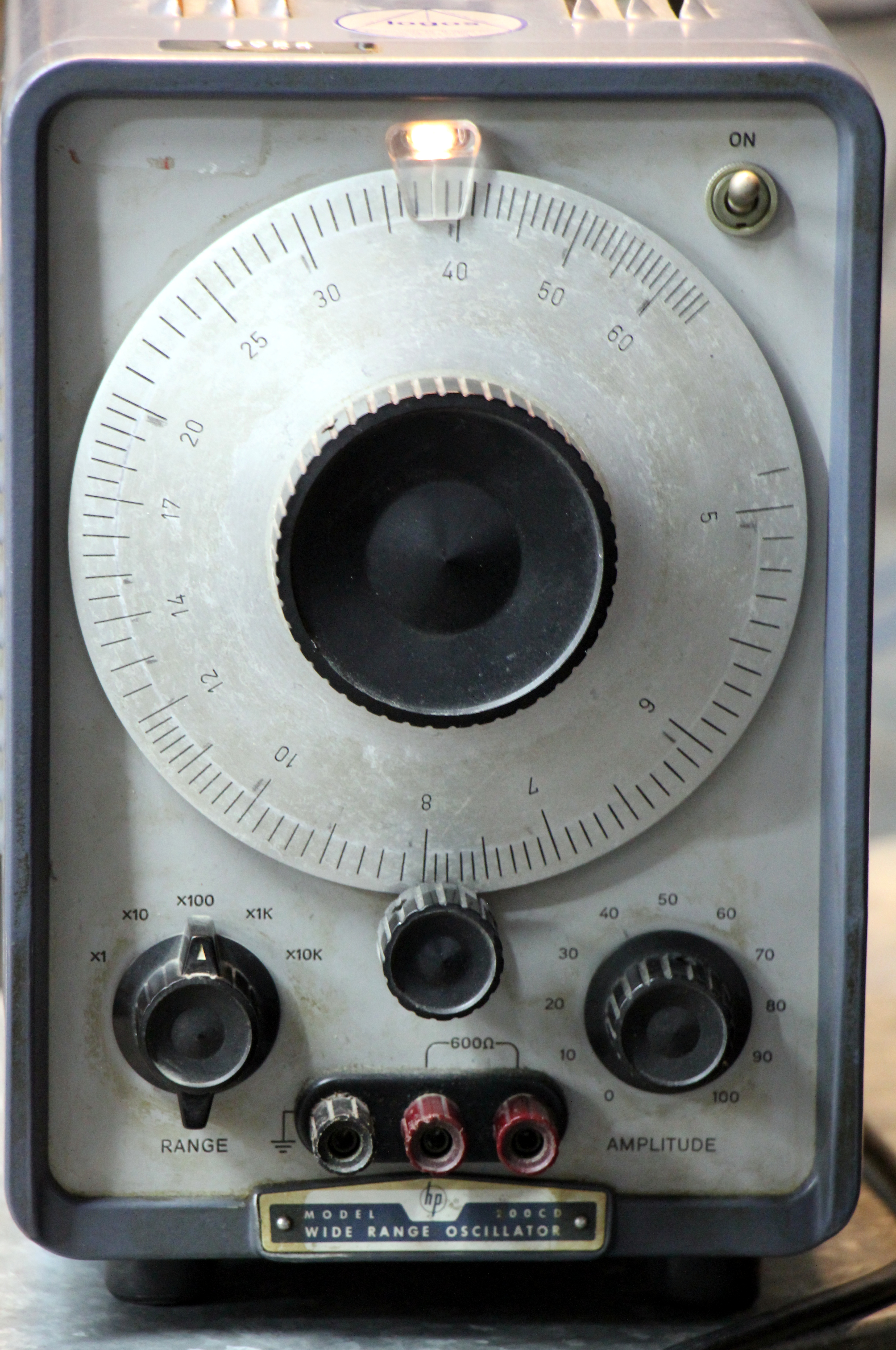 The first model of this generator was produced in 1939 (model HP200A) and the
big innovation it brought was the amplitude stabilisation circuit using an incandescent
bulb as voltage dependent resistor in the negative feedback loop. Here is the
principle circuit as taken from the patent application:
The first model of this generator was produced in 1939 (model HP200A) and the
big innovation it brought was the amplitude stabilisation circuit using an incandescent
bulb as voltage dependent resistor in the negative feedback loop. Here is the
principle circuit as taken from the patent application: 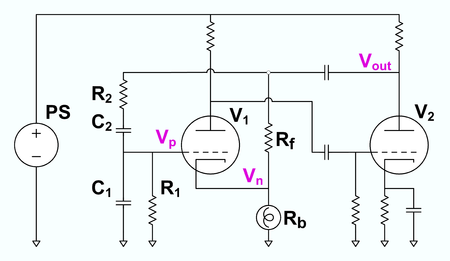 The
Wien-bridge components are C1, C2, R1, R2. The idea to use a bulb to stabilise
amplitude can be attributed to Larned Meacham in 1937. Ever since -and even
today!- this principle has found applications in numerous practical circuits,
many of them with high relevance for audio equipment and electronic musical
instruments.
The
Wien-bridge components are C1, C2, R1, R2. The idea to use a bulb to stabilise
amplitude can be attributed to Larned Meacham in 1937. Ever since -and even
today!- this principle has found applications in numerous practical circuits,
many of them with high relevance for audio equipment and electronic musical
instruments.
Another, more recent and transistorized, popular lab model
was this one by Leader: 
The circuit in use for variable frequency sine wave generators
was very often a Wien-bridge, with variable capacitor. This was for instance
the case for this assembly of 12 vacuum tube sine wave oscillators that were
designed at the IPEM studio in the mid sixtees:
 The
upper row of knobs are rotary switches to set the frequency range, the second
row -using multiturn knobs- are used the set the frequency, the bottom row has
a switch to select the output channel and a potentiometer to set the amplitude.
The mixer is part of the internal circuit.
The
upper row of knobs are rotary switches to set the frequency range, the second
row -using multiturn knobs- are used the set the frequency, the bottom row has
a switch to select the output channel and a potentiometer to set the amplitude.
The mixer is part of the internal circuit.
As said above, the Wien-bridge base oscillator was not invented
and build until 1938. In early electronic instruments such
as the Theremin as well as in the Ondes Martenot
, the oscillators are invariably based on heterodyning. The advantage being
that it was easy to sweep through the entire range of audible frequencies, without
a need to change the range. This worked, but very much at the detriment of precision
and stability. On 'normal', Wien-bridge based oscilators, the range on the big
dial was a decade ( 1 :10, with a little extra, for overlap with the next/previous
range).
Since the early seventies though, quite a selection of integrated
circuits (chips) became available that made it pretty easy to make and design
a sine wave generator. The most popular chip -still available at the time of
this writing- being the Exar XR2206.
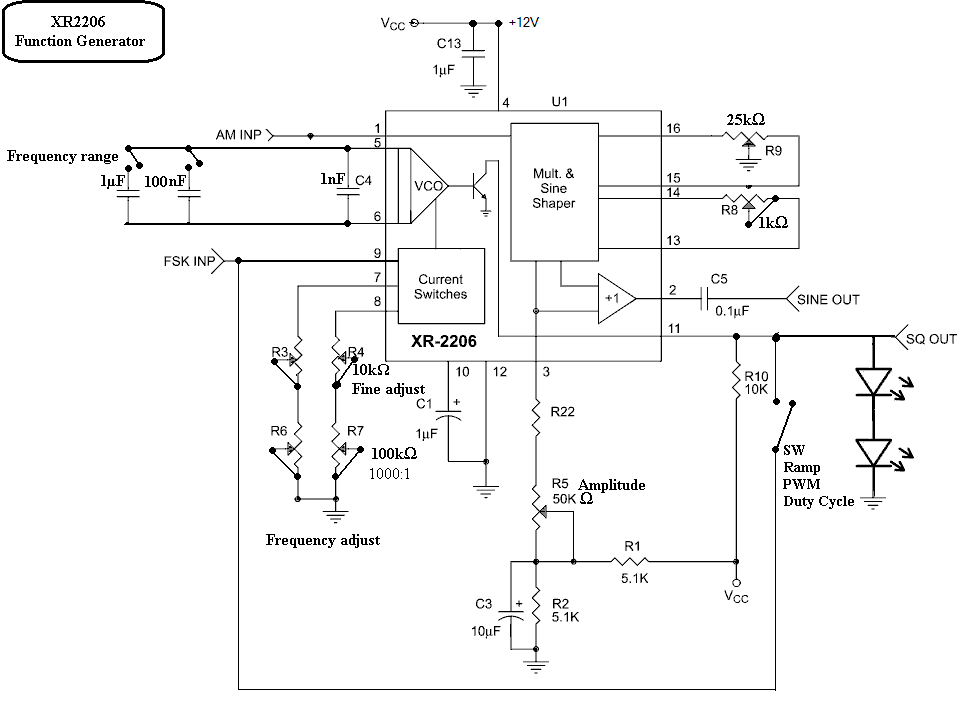
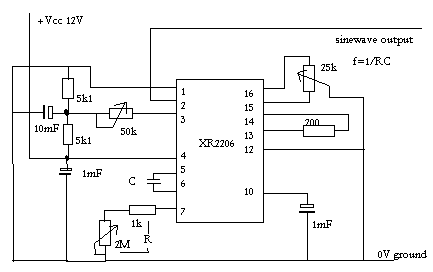
Many sine wave oscillators came on the market, using this chip:
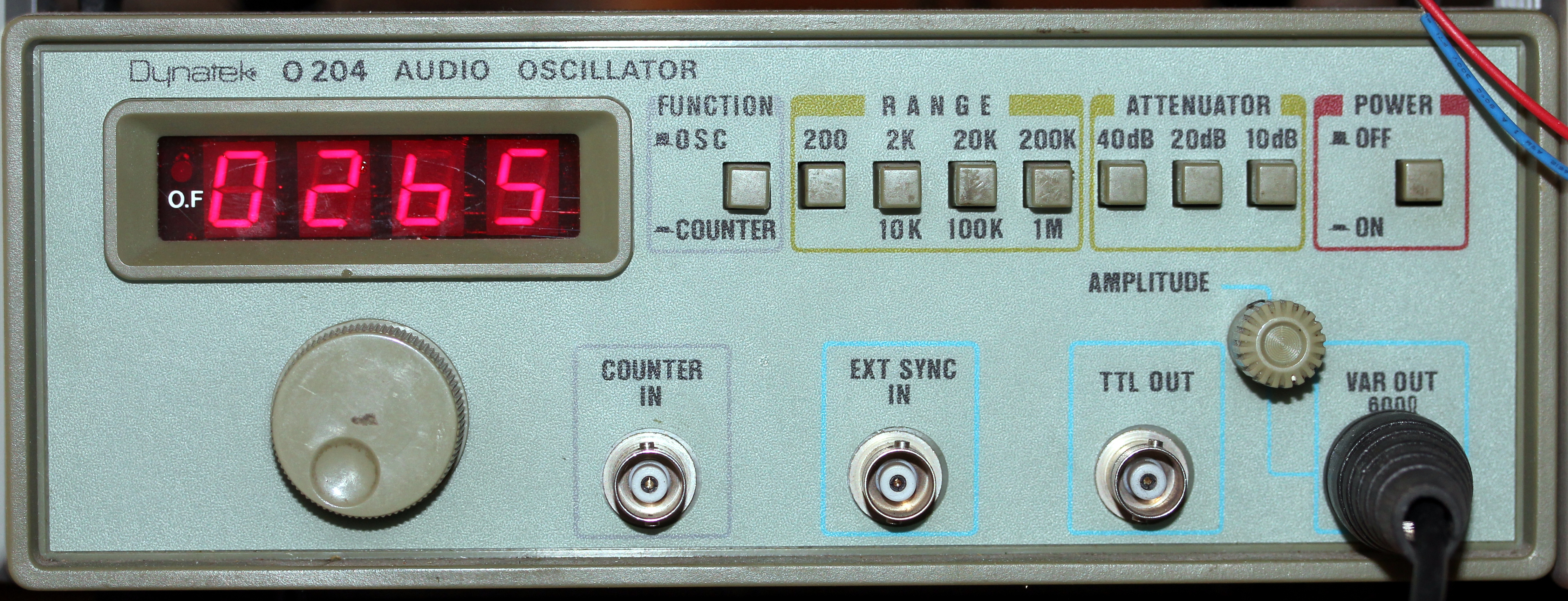
2.- The relaxation oscillator (sawtooth)
Presumably the simplest circuit one could think off, as it
uses just a small neon-filled glowbulb, a resistor and a capacitor. By making
the resistor variable, tuning is possible over a large range. The range can
be selected, by allowing selection of different capacitors. If the operating
voltage is high enough, a variable capacitor (500pF or so) can be used also
to continuously vary the frequency. Here is a practical circuit, wherein a FET-input
opamp is used to buffer the very high impedance of the oscillator: 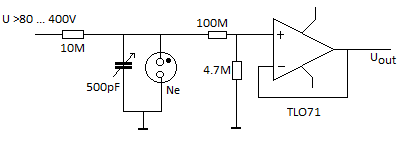
This oscillator type found application in the Philips 'Philicorda',
the electronic Hohner accordions and many more brands of musical instruments.
The dodekadent, developed by us for the Logos workshop in 1969, also used relaxation
oscillators, in this case used as voltage controlled oscillators. The control
voltages were between 65 V and 550 V for a range covering many octaves...
In the seventies the discharge-bulb design became less popular
as a new component came up: the unijunction transistor. This component could
easily be used to design a sawtooth oscillator very similar to the circuit using
a bulb. Here is a circuit: 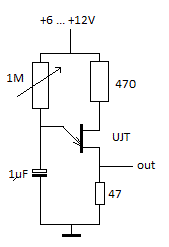
3.- The multivibrator (square wave)
The multivibrator operates a bit like an oscillating on-off
switch: if it switches off, it switches itself on again and vice versa. The
speed wherewith it changes on-off or off-on states depends on the value of the
two capacitors in the circuit. In the first half of the 20th century the circuit
was build using double triode valves, but pure electromechanical versions were
made as well. The latter used relays and were applied massively in telephone
exchange stations as well as in power supplies for vacuum tube radios in cars
( so called 'vibrators'). With the advent of semiconductors and the beginnings
of digital technology, the term 'flip-flop' became the common name for the multivibrator
circuit, basically a 1-bit memory element in a feedback configuration.
4.- The pulse- or spike generator
This type of generator found its main application as a triggering
device for other circuitry. It can be used for generating spikes and bursts
on its own, but also to synchronize different oscillators, sequencing devices.
The circuit mostly used here is the one-shot. A very common circuit to implement
it, is based on the well known and ever popular 555 chip.
5.- The noise generator
This type of generator, an essential part of all acoustics
labs since the first half of the 20th century, produces white noise. This white
noise can be limited in bandwidth to create different kinds of colored noise.
Pink noise is a special form of noise, obeying to the 1/f distribution. To change
noise characteristics, filters are used and most often one will find these integrated
in the generator. The type produced by Bruel-Kjoer, up to the mid seventies,
could be encountered in all electronic music studios all over the world. For
application in live-electronics, this type of generator was way too bulky (and
expensive...) and thus a whole gamut of simple, often self-made, circuits came
into existence to generate noise.
Noise generators in chip form became popular in the seventies,
but these use a digital approach to generate pseudo-random noise. Indeed, this
type of noise after low pass filtering, reveals its digital origin by producing
a clearly recognisable always repeating pattern. Circuits based on these chips
once were very popular in live electronics.
6.- Top octave generator.
This type of generator does not provide in a variable frequency,
but instead generates a full octave of equal tempered very high pitches. These
were used in the design and construction of all sorts of electronic organs and
other keyboard instruments. Each of the twelve outputs of this generator was
fed to a cascade of dividers, such that all pitches in all octaves below the
pitch generated could be produced simultaneously. The chips used for this type
of generator are since long out of production and there is no alternative for
them, apart from redesigning the entire circuit using microprocessors.
The top octave generator was a great improvement in electronic
organ design, as it circumvented the problem of having to tune minimum twelve
independent oscillators with regular intervals. Using this generator chip, the
tuning of the entire instrument could be fine-tuned by adjusting just a single
potmeter or trimcap.
Digital synthesis of arbitrary waveshapes
Sine waves, and for that matter in fact any periodic waveshape,
can be generated digitally. The principle is to implement a ring-counter and
a DAC circuit. The ringcounter sends a list of n values taken from a lookup
table to the DAC at a given clock frequency, corresponding to n times the frequency
of the signal to be generated. The precision is a function of the number of
steps: with 256 steps we get 8-bit resolution.
It is of interest here, to draw attention to the fact that
this approach to sound synthesis is technically almost identical to the concept
of a sequencer. The difference is only in the speed of the clock used. On a
philosophical level, the idea that audible sounds can be brought down in frequency
until they become rhythms , has been a source of inspiration for many composers.
Karlheinz Stockhausen, used the concept both musically and philosophically in
pieces such as 'Hymnen'.
Here is a picture of a laboratory arbitrary function generator
made my Tektronix, our favorite of all times, although it cannot be used for
live electronic performances: it does not have an easy to use dial knob for
frequency and it has a fan, making noise...
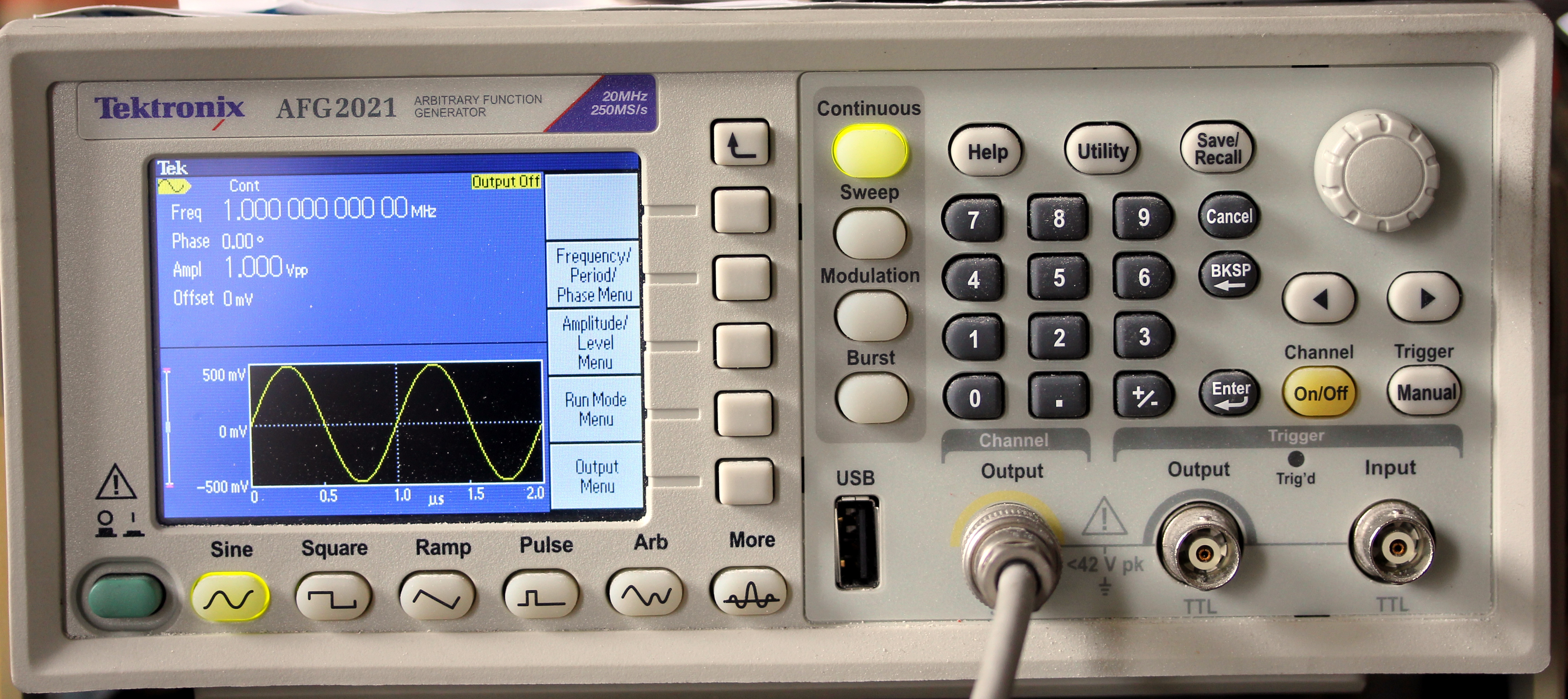
Use as a musical
instrument
The use of wave generators in electronic
music studios in the fifties and sixties set aside, (sine)wave oscillators have
been used very often in musical performances, on stage that is. The knobs and
dials wherewith the frequency was to be controlled often didn't allow precise
enough setting of the pitches as precribed in the composers scores. The answer
to that problem was the addition of a digital frequency counter to monitor the
output frequency. With such a counter, the frequency became readible with high
precision. However, the problem was that these counters had a rather slow response
time. One second for a measurement precision of 1 Hz is normal.
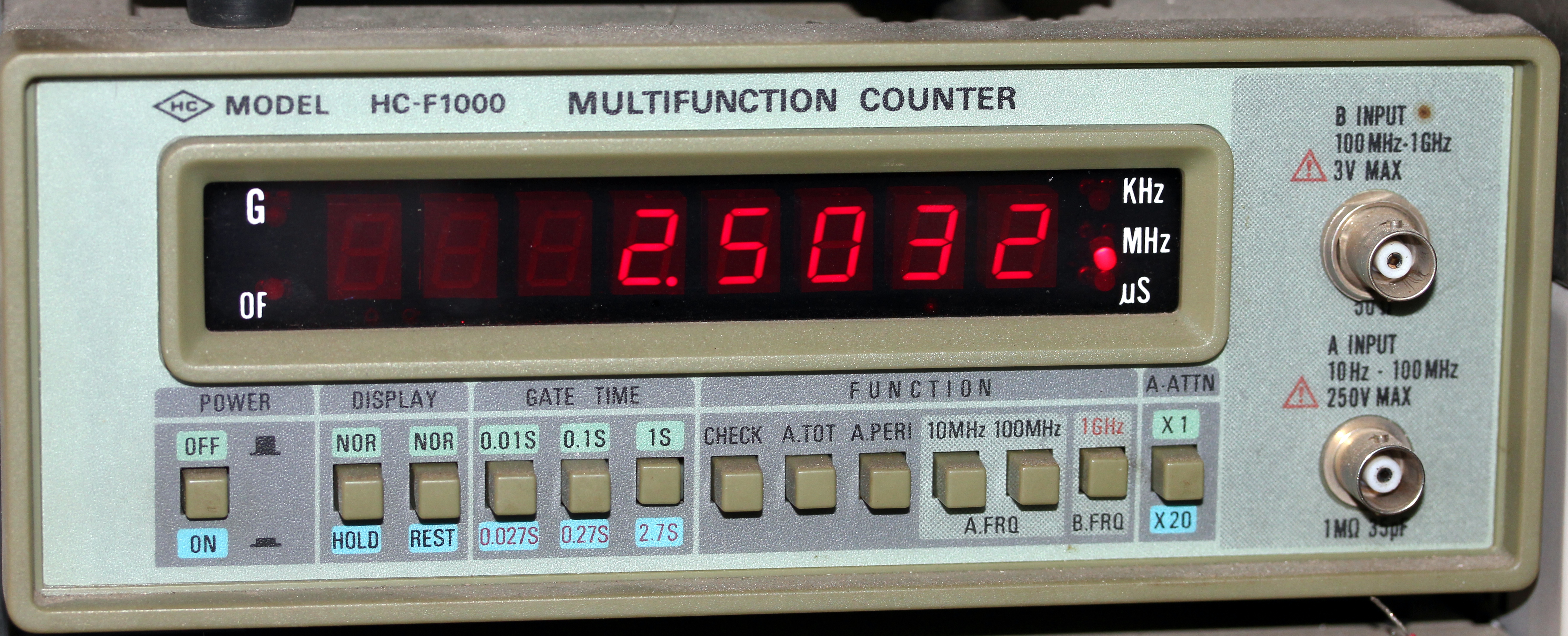
An alternative that became available only since the 21th century,
is to use a digital tuner device such as made by Korg, Casio and other brands.
There are now even a wide range of apps for smartphones available with just
that function.
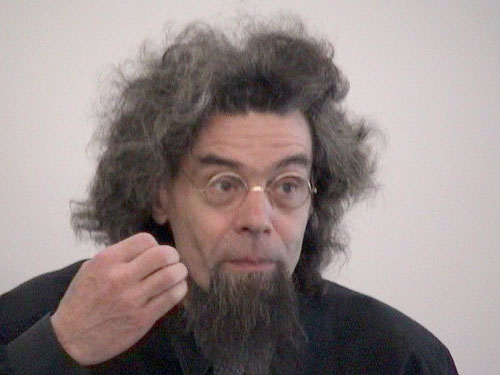 |
This article -under construction- is part of a research project on Experimental
Legacy financed in part by the Orpheus Institute in Ghent.
www.orpheusinstituut.be
|
 The
Wien-bridge components are C1, C2, R1, R2. The idea to use a bulb to stabilise
amplitude can be attributed to Larned Meacham in 1937. Ever since -and even
today!- this principle has found applications in numerous practical circuits,
many of them with high relevance for audio equipment and electronic musical
instruments.
The
Wien-bridge components are C1, C2, R1, R2. The idea to use a bulb to stabilise
amplitude can be attributed to Larned Meacham in 1937. Ever since -and even
today!- this principle has found applications in numerous practical circuits,
many of them with high relevance for audio equipment and electronic musical
instruments.  The
upper row of knobs are rotary switches to set the frequency range, the second
row -using multiturn knobs- are used the set the frequency, the bottom row has
a switch to select the output channel and a potentiometer to set the amplitude.
The mixer is part of the internal circuit.
The
upper row of knobs are rotary switches to set the frequency range, the second
row -using multiturn knobs- are used the set the frequency, the bottom row has
a switch to select the output channel and a potentiometer to set the amplitude.
The mixer is part of the internal circuit.



